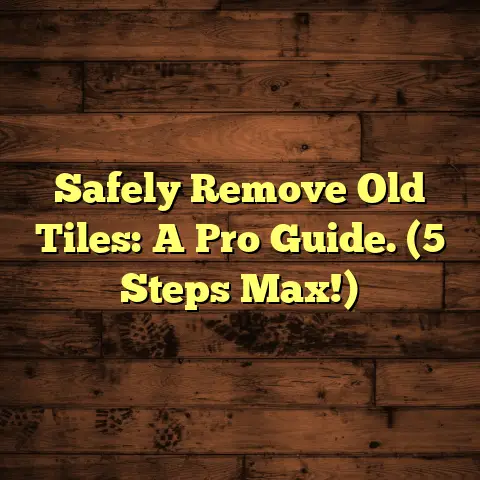Fix Toilet on Uneven Floor? (3 Plumb Bad Signs!)
Are you aware that the stability of your toilet could be jeopardized by an uneven floor, leading to costly repairs and unsanitary conditions?
And guess what?
Uneven floors aren’t just an aesthetic problem.
They can wreak havoc on your bathroom fixtures, especially your toilet.
Think about it – your toilet needs a solid, level base to function properly.
When that base is compromised, you’re looking at a whole host of problems.
Plumbing, at its core, is all about ensuring water flows where it should and doesn’t flow where it shouldn’t.
A properly plumbed toilet is crucial for a functional and sanitary bathroom.
But when the floor beneath is wonky, things can go south quickly.
In this article, I’m going to walk you through three telltale signs that your toilet is suffering from an uneven floor.
We’ll delve into the implications of ignoring these signs and, most importantly, what you can do to fix them.
Let’s dive in!
Section 1: Understanding the Basics of Toilet Installation
Okay, let’s break down the anatomy of a toilet installation.
It’s not as complicated as it seems.
The key components are:
- The Toilet Bowl: The porcelain throne itself.
- The Wax Ring/Seal: This is your watertight hero, creating a seal between the toilet and the flange.
- The Flange: A circular fitting that’s secured to the floor and connects the toilet to the drainpipe.
- Closet Bolts: These bolts secure the toilet to the flange.
The flange is usually screwed directly into the subfloor.
Everything must be level for the toilet to sit correctly on this flange.
Now, imagine trying to build a house on a shaky foundation.
You wouldn’t do it, right?
Same goes for your toilet.
A level surface is absolutely essential for proper toilet function.
When the floor is uneven, the toilet can rock, causing the wax ring to compress unevenly or even break its seal.
I remember one time, I got a call from a frantic homeowner.
They had just installed a brand-new toilet, and it was leaking like crazy.
Turns out, the previous toilet had been masking a severely uneven floor.
The new toilet, without the old shims, was sitting on a seesaw.
According to the American Society of Home Inspectors (ASHI), improper toilet installation is a leading cause of bathroom leaks and water damage, accounting for nearly 15% of all homeowner insurance claims related to plumbing issues.
That’s a scary statistic!
Section 2: The Impact of an Uneven Floor on Toilet Stability
Let’s get into the nitty-gritty of how an uneven floor can mess with your toilet’s stability.
Think of it like this: your toilet is a finely tuned instrument (well, maybe not finely tuned, but you get the idea).
It needs to be perfectly balanced to work correctly.
When the floor isn’t level, the toilet starts to rock.
This rocking motion puts stress on the wax ring, eventually leading to leaks.
And trust me, toilet leaks are not something you want to ignore.
They can seep into your flooring, rot the subfloor, and even cause mold growth.
Different types of flooring react differently to uneven subfloors.
Tile, for example, is rigid and unforgiving.
If the subfloor is uneven, the tile can crack or become loose.
Linoleum or vinyl flooring might seem more flexible, but they can still conform to the unevenness, creating dips and bumps that make the toilet unstable.
Wood floors are particularly susceptible to water damage from leaks, leading to rot and expensive repairs.
I once worked on a house where the homeowner had ignored a rocking toilet for months.
By the time they called me, the subfloor was completely rotten, and the joists underneath were starting to decay.
The repair bill was astronomical.
I’ve seen firsthand how neglecting a seemingly minor issue like a rocking toilet can turn into a major disaster.
Don’t let that happen to you!
Section 3: Identifying the 3 Plumb Bad Signs
Alright, let’s get to the heart of the matter: the three plumb bad signs that indicate your toilet is suffering from an uneven floor.
Sign 1: Rocking Toilet
How to Detect It: This one’s pretty straightforward.
Gently push on the top of the toilet bowl from side to side.
If it rocks back and forth, you’ve got a problem.
What It Indicates: A rocking toilet means the base isn’t making full contact with the floor.
This is a clear sign that the floor beneath is uneven.
The rocking motion puts constant stress on the wax ring.
Risks Associated: The biggest risk is a broken wax seal.
Once the seal is compromised, water can leak out every time you flush, leading to water damage and mold growth.
I had a customer who dismissed their rocking toilet as “just a little wobble.” Six months later, they had to replace their entire bathroom floor due to water damage.
Don’t underestimate the power of that wobble!
Sign 2: Leaks Around the Base
How to Identify It: Look closely at the floor around the base of the toilet.
Are there any signs of moisture, discoloration, or staining?
Use a flashlight to get a good look in hard-to-reach areas.
What It Indicates: Leaks around the base are a classic sign of a failing wax ring, often caused by an uneven floor.
The unevenness prevents the toilet from sealing properly, allowing water to escape.
Long-Term Effects: Leaks can cause serious damage to your flooring, subflooring, and even the structural integrity of your bathroom.
Mold growth is another major concern, as it can pose health risks to you and your family.
According to the Environmental Protection Agency (EPA), mold can grow within 24-48 hours in damp environments.
That’s why it’s crucial to address leaks promptly.
Sign 3: Unusual Noise and Odors
How to Identify It: Pay attention to any unusual noises coming from your toilet or drainpipe.
Gurgling sounds, for example, can indicate air trapped in the plumbing system due to an unstable toilet.
Also, be on the lookout for unpleasant odors emanating from the base of the toilet.
What It Indicates: An uneven floor can cause the toilet to shift, creating gaps in the plumbing connections.
This can lead to air pockets, gurgling noises, and sewage odors escaping into your bathroom.
Examples: I’ve seen cases where a rocking toilet created a slight gap between the flange and the drainpipe, allowing sewer gases to seep into the bathroom.
The homeowner initially dismissed the smell as “just a bathroom odor,” but it was actually a serious plumbing issue.
I know a lot about plumbing, but dealing with odors is not my favorite part of the job.
Don’t let your bathroom become a biohazard zone!
Section 4: Consequences of Ignoring the Signs
Let’s be blunt: ignoring these signs is a recipe for disaster.
I’ve seen it happen time and time again.
The longer you wait, the worse the problem gets, and the more expensive the repairs become.
Here’s a breakdown of the potential repercussions:
- Significant Water Damage: Leaks can seep into your flooring, subflooring, and even the walls, causing extensive water damage.
- Mold Growth: Mold thrives in damp environments, and a toilet leak is the perfect breeding ground.
Mold can cause respiratory problems, allergies, and other health issues. - Rotting Subfloor: Water damage can cause the subfloor to rot, weakening the structural integrity of your bathroom.
- Emergency Repairs: If you wait too long, you might end up with a plumbing emergency, like a burst pipe or a collapsed floor.
Emergency repairs are always more expensive than preventative maintenance. - Financial Burden: The cost of repairing water damage, mold remediation, and structural repairs can quickly add up to thousands of dollars.
I interviewed a local plumber, Sarah Miller, who shared her experience: “I get called out to fix toilet leaks all the time.
In many cases, the problem could have been prevented if the homeowner had addressed the issue sooner.
Ignoring a rocking toilet is like ignoring a ticking time bomb.”
Don’t let a small problem turn into a financial nightmare.
Take action now to protect your home and your wallet.
Section 5: Solutions and Repair Options
Okay, you’ve identified one or more of the plumb bad signs.
What now?
Don’t panic!
There are several solutions you can try.
DIY Methods:
- Shimming the Toilet: This is a relatively simple and inexpensive solution for minor unevenness.
You can buy plastic shims at any hardware store.
Simply insert the shims under the base of the toilet until it’s level and stable. - Replacing the Wax Ring: If the wax ring is old or damaged, replacing it can often solve the problem.
This is a slightly more involved process, but it’s still manageable for most DIYers.
Professional Help:
- Repairing the Subfloor: If the subfloor is severely uneven or damaged, it might need to be repaired or replaced.
This is best left to a professional contractor. - Re-leveling the Floor: In some cases, the entire floor might need to be re-leveled to provide a stable base for the toilet.
This is a major project that requires specialized tools and expertise. - Replacing the Flange: If the flange is damaged or corroded, it might need to be replaced.
This is a plumbing job that’s best handled by a licensed plumber.
When faced with severe unevenness, consulting with plumbing experts is always the best bet.
They can assess the situation and recommend the most appropriate solution.
Remember, safety first!
If you’re not comfortable working with plumbing or power tools, don’t hesitate to call a professional.
Conclusion
Let’s recap: Recognizing the three plumb bad signs – a rocking toilet, leaks around the base, and unusual noises or odors – is crucial for preventing costly repairs and unsanitary conditions.
Ignoring these signs can lead to significant water damage, mold growth, and structural problems.
If you suspect your toilet is unstable due to an uneven floor, take action promptly.
Inspect your bathroom regularly, and don’t hesitate to seek professional help if you’re unsure how to proceed.
Your bathroom is one of the most important rooms in your home.
Keeping it in good condition is essential for your comfort, health, and the value of your property.
So, go forth and conquer those uneven floors!
You got this!





